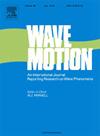Soliton-like waves in the coastal zone of the eastern coast of Sakhalin Island
IF 2.5
3区 物理与天体物理
Q2 ACOUSTICS
引用次数: 0
Abstract
An analysis of a time series of sea level oscillations with a total observation duration of about 14 years was carried out. The aim of the research was to study the possibilities of generating soliton-like waves in the form of wave packets with a soliton envelope. Bottom autonomous wave recorders models ARW-10 to ARW-14K, with one second discretization, were installed in the coastal zone of the southeastern coast of Sakhalin Island. The wave time series were subjected to bandpass filtering in the period range of 15 min to 3 h, revealing nine events in which the amplitudes of anomalous waves exceeded the background level by more than twice. For the selected events, modeling using the time-like form of the Korteweg–de Vries (KdV) equation was performed, showing that the soliton serves as the envelope for the registered wave packets. The possibility of describing such packets using breathers was considered, as each event presented a wave packet rather than a single wave, indicating modulation of the soliton envelope. A possible mechanism for the generation of soliton-like waves was considered, and a criterion for the range of propagation speeds of these waves was proposed, analogous to tsunami waves, as both are long waves. Using the speed range and distances to potential seismic sources of anomalous waves, determined from maps, intervals of seismic events from August 2008 to June 2022 with magnitudes greater than 5, corresponding to the possible arrival of anomalous waves at the coast of Sakhalin Island, were identified. From these waves, the one whose arrival time coincided with the observation time of the soliton-like wave was selected, and it was determined which earthquake could have generated the arriving wave. It was found that four events from the selected ones met the condition of soliton-like waves arriving from seismic sources at the observation point. It was shown that despite the assumptions made in choosing the criterion for the propagation speed of soliton-like waves, the interval of time during which a particular earthquake occurred was determined uniquely, and no other earthquakes fell into it. The obtained result suggests that the generation of soliton-like waves may be associated with seismic sources; however, this issue requires separate detailed studies.
库页岛东岸海岸带的孤子状波浪
对一个总观测持续时间约为14年的海平面振荡时间序列进行了分析。这项研究的目的是研究以带孤子包络的波包形式产生类孤子波的可能性。ARW-10至ARW-14K型海底自主波记录仪被安装在库页岛东南海岸的沿海地区,具有一秒钟的离散化。对15 min ~ 3 h的波时间序列进行带通滤波,得到9个异常波幅度超过背景水平2倍以上的事件。对于选定的事件,使用Korteweg-de Vries (KdV)方程的类时形式进行建模,表明孤子充当了注册波包的包络层。考虑了使用呼吸器描述这种包的可能性,因为每个事件呈现一个波包而不是单个波,这表明了孤子包络的调制。考虑了产生类孤子波的可能机制,并提出了这些波的传播速度范围的标准,类似于海啸波,因为它们都是长波。利用从地图上确定的异常波的速度范围和到潜在震源的距离,确定了2008年8月至2022年6月期间震级大于5级的地震事件间隔,对应于可能到达库页岛海岸的异常波。从这些波中,选择到达时间与类孤子波观测时间一致的波,并确定哪一次地震可能产生了到达波。结果表明,选取的地震事件中有4个事件满足从震源到达观测点的类孤子波的条件。结果表明,尽管在选择类孤子波传播速度的判据时作了假设,但某一特定地震发生的时间间隔是唯一确定的,并且没有其他地震落入该时间间隔。所得结果表明,类孤子波的产生可能与震源有关;然而,这个问题需要单独的详细研究。
本文章由计算机程序翻译,如有差异,请以英文原文为准。
求助全文
约1分钟内获得全文
求助全文
来源期刊

Wave Motion
物理-力学
CiteScore
4.10
自引率
8.30%
发文量
118
审稿时长
3 months
期刊介绍:
Wave Motion is devoted to the cross fertilization of ideas, and to stimulating interaction between workers in various research areas in which wave propagation phenomena play a dominant role. The description and analysis of wave propagation phenomena provides a unifying thread connecting diverse areas of engineering and the physical sciences such as acoustics, optics, geophysics, seismology, electromagnetic theory, solid and fluid mechanics.
The journal publishes papers on analytical, numerical and experimental methods. Papers that address fundamentally new topics in wave phenomena or develop wave propagation methods for solving direct and inverse problems are of interest to the journal.
 求助内容:
求助内容: 应助结果提醒方式:
应助结果提醒方式:


